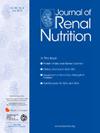维持性血液透析患者EWGSOP 1与EWGSOP 2诊断肌少症的可靠性及与临床参数的相关性
IF 3.4
3区 医学
Q2 NUTRITION & DIETETICS
引用次数: 0
摘要
目的:分析欧洲老年人肌少症工作组(EWGSOP)提出的肌少症标准1和标准2之间的可靠性,验证维持性血液透析患者肌少症诊断与临床参数的相关性。方法:横断面分析纳入维持性血液透析的成人患者。采用双能x线吸收仪(DXA)评估瘦质量,计算阑尾瘦质量指数。肌肉力量的评估是用握力计进行的。肌少症诊断考虑的截止值由EWGSOP 1和EWGSOP 2标准提出。结果:纳入124例患者。EWGSOP 1诊断肌少症的频率(25.8%)高于EWGSOP 2(12.9%)。肌少症的诊断频率在两性中均有所下降。两个标准间的信度为中等(κ = 0.597;结论:EWGSOP 1对血透患者肌少症的诊断频次高于EWGSOP 2,两标准间的信度为中等。EWGSOP 1诊断的肌少症与糖尿病和血清铁有关,可能与肌少症的发病有关。EWGSOP 2与评估的临床参数无关。本文章由计算机程序翻译,如有差异,请以英文原文为准。
Reliability Between Sarcopenia Diagnosis by EWGSOP 1 and EWGSOP 2 Criteria and Association With Clinical Parameters in Maintenance Hemodialysis Patients
Objectives
To analyze the reliability between the sarcopenia criteria proposed by the European Working Group on Sarcopenia in Older People (EWGSOP) 1 and 2 and to verify the association of clinical parameters with sarcopenia diagnosis in patients on maintenance hemodialysis.
Methods
Cross-sectional analysis including adult patients on maintenance hemodialysis. The assessment of lean mass was performed by dual-energy X-ray absorptiometry, and the appendicular lean mass index was calculated. The assessment of muscle strength was performed using a handgrip dynamometer. The cutoff values considered for sarcopenia diagnosis were proposed by the EWGSOP 1 and EWGSOP 2 criteria.
Results
124 patients were included. The frequency of sarcopenia diagnosis was higher according to EWGSOP 1 (25.8%) than according to EWGSOP 2 (12.9%). The frequency of sarcopenia diagnoses diminished in both sexes. The reliability between the two criteria was moderate (κ = 0.597; P < .001), and 87.1% of patients were classified equally by both criteria. In EWGSOP 1, the presence of diabetes and serum iron was significantly higher in the group with sarcopenia, and in EWGSOP 2 there was no such difference.
Conclusion
The frequency of sarcopenia diagnosis in patients on hemodialysis was higher by EWGSOP 1 compared to EWGSOP 2, and the reliability between the criteria was moderate. Sarcopenia diagnosed by EWGSOP 1 was associated with diabetes and serum iron, which are factors that may be associated with sarcopenia pathogenesis. EWGSOP 2 was not associated with the clinical parameters assessed.
求助全文
通过发布文献求助,成功后即可免费获取论文全文。
去求助
来源期刊

Journal of Renal Nutrition
医学-泌尿学与肾脏学
CiteScore
5.70
自引率
12.50%
发文量
146
审稿时长
6.7 weeks
期刊介绍:
The Journal of Renal Nutrition is devoted exclusively to renal nutrition science and renal dietetics. Its content is appropriate for nutritionists, physicians and researchers working in nephrology. Each issue contains a state-of-the-art review, original research, articles on the clinical management and education of patients, a current literature review, and nutritional analysis of food products that have clinical relevance.
 求助内容:
求助内容: 应助结果提醒方式:
应助结果提醒方式:


